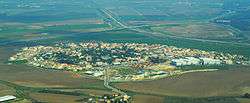Yad Binyamin
| Yad Binyamin יַד בִּנְיָמִין | |
|---|---|
 | |
 Yad Binyamin  Yad Binyamin | |
| Coordinates: 31°47′49.92″N 34°49′16.68″E / 31.7972000°N 34.8213000°ECoordinates: 31°47′49.92″N 34°49′16.68″E / 31.7972000°N 34.8213000°E | |
| District | Central |
| Council | Nahal Sorek |
| Founded | 1962 |
| Population (2017)[1] | 4,049 |
| Name meaning | Binyamin Memorial |
Yad Binyamin (Hebrew: יַד בִּנְיָמִין, lit. Binyamin Memorial)[2] is a community settlement in central Israel. The seat of Nahal Sorek Regional Council, it is located adjacent to the junction of three major highways: Highway 3, Highway 6, and Highway 7. In 2017 it had a population of 4,049.[1]
History

Yad Binyamin was founded on the land of the depopulated Palestinian village of Al-Mukhayzin.[3] The land had been used as a Ma'abara Nativa which was abandoned as a religious settlement and educational center in 1962 by Poalei Agudat Yisrael, in partnership with the municipality of Nahal Sorek.[4] It was named after the former Minister of Postal Services, Binyamin Mintz, who had died the previous year.[5] For many years, the community was a center of higher Jewish learning, based around the yeshiva.[5]
Following the disengagement plan, around 200 families from Gush Katif moved into temporary pre-fabricated housing in Yad Binyamin. Some later moved to a new village named Ganei Tal after the former settlement by the same name.[6] Many other families have moved to Netzer Hazani.[7]
Transportation
Yad Binyamin is located 3 kilometres (1.9 mi) from the Re'em Junction on Highway 3, and one kilometer from the intersection of Highway 6 and Highway 7. Israel Railways plans to upgrade the tracks of nearby Tel Aviv–Beersheba line and build a station at Kfar Menahem to serve the area, which is scheduled to be completed by January 2018.[8] A number of Egged bus routes provide transport links to Jerusalem, Ashkelon, and other cities.
References
- 1 2 "List of localities, in Alphabetical order" (PDF). Israel Central Bureau of Statistics. Retrieved August 26, 2018.
- ↑ For the derivation of "yad" (normally "hand") meaning a memorial, see http://www.jewishvirtuallibrary.org/jsource/judaica/ejud_0002_0021_0_21157.html
- ↑ Khalidi, W. (1992). All That Remains: The Palestinian Villages Occupied and Depopulated by Israel in 1948. Washington D.C.: Institute for Palestine Studies. p. 398. ISBN 0-88728-224-5.
- ↑ http://www.homee.co.il/%D7%99%D7%93-%D7%91%D7%A0%D7%99%D7%9E%D7%99%D7%9F/
- 1 2 https://books.google.co.uk/books?id=a5vXAAAAMAAJ&q=%22yad+binyamin%22+memorial&dq=%22yad+binyamin%22+memorial&hl=en&sa=X&ved=0ahUKEwj30LTYm6jRAhXcN1AKHTThD0MQ6AEILzAD
- ↑ "1,100 evacuee families to stay together". The Jerusalem Post. 7 November 2005.
- ↑ Shomron, Shifra (5 October 2013). "New Beginnings: Netzer Harani". Jewish Press. Retrieved 18 November 2013.
- ↑ "Kfar Menachem Train Station". ויקיפדיה (in Hebrew). 2016-10-01.